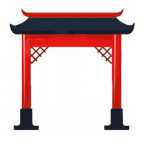| Meaning |

to open, start, turn on 开
|
| Explanation |
Can be seen as the entrance gate of a Buddhist temple with two traverses. This gate is always open.
|
Used in these characters:
|
|
开
|
 |
|
JLPT HSK 1 |
|
| to open, to start, to turn on
|
Shows an open gate with a double cross-bar, as it is common at the entrance of Buddhist temples and means: "open".

|
|
|
|
并
|
 |
|
JLPT HSK 4 |
|
| to combine, to merge, also
|
Top: out of 丷, below: open 开 (= the entrance gate of a buddh. temple)
When you are coming out of the open temple's gate, you shall be combined/united.

|
|
|
|
研
|
 |
|
JLPT HSK 4 |
|
| to grind, study, to rub, research
|
Left: stone 石 (At the cliff 厂 is a stone 口), right: open, start 开 (image of the entrance gate of a buddhistic temple)
(Only polished gems show their beauty.) A stone is "opened" when it is grinded to shine for being studied.

|
|
|
|
形
|
 |
|
JLPT HSK 5 |
|
| appearance, shape, form
|
Left: open, start 开 (image of the entrance gate of a buddh. temple), right: hair 彡
With open hair you are in good appearance.

|
|
|
|
型
|
 |
|
JLPT HSK 5 |
|
| form, model, type (e.g. blood type)
|
Top: punishment 刑 (who openly 开 [=gate at temple] uses his knife刂 is punished.), earth: 土
Use an open knife and earth (=clay) to form a model.

|
|
|
|
刑
|
 |
|
JLPT HSK 6 |
|
| punishment, penalty, sentence
|
Left: open, start 开 (image of the entrance gate of a buddh. temple), right: knife 刂
Who openly uses his knife, will be: punished.

|
|
|
|
邢
|
 |
|
JLPT no HSK |
|
| (place name), surname Xíng
|
Left: open, start 开 (Image of the entrance gate of a buddh. temple), right: village⻏
An entrance gate at this village.

|
|
|
| Radicals are shown here that are similar either in appearance or meaning. |  |
|
At the page you get the memory phrases for learning the Chinese Hanzi. If you are learning the Japanese kanji, please follow this link. |
List of the characters |
List of the radicals
|

